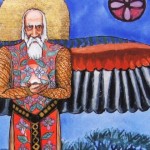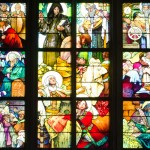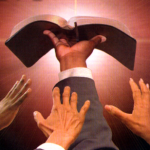I am currently discovering D.H. Lawrence, who was a kind of proto-Pagan. I just came across the following discussion of symbols in his Apocalypse. Written in 1930, Lawrence’s Apocalypse is a re-imagination of the Book of Revelation as a ritual initiation into a pagan mystery religion. Lawrence speaks of symbols in much the same way that I discussed poetry and ritual in my previous post, as unconscious and as transcending all attempts at fixing a “meaning”. When Lawrence speaks about symbols as having a life of their own, it calls to mind Jung’s conception of archetypes. I think it worth reproducing his words largely intact here. Lawrence writes about the theories of the meaning of the Book of Revelation, Apocalypse, but then asks:
But who cares? We do not care, vitally, about theories of the Apocalypse: what the Apocalypse means. What we care about is the release of the imagination. A real release of the imagination renews our strength and our vitality, makes us feel stronger and happier. Scholastic works don’t release the imagination: at the best, they satisfy the intellect, and leave the body an unleavened lump. But when I get the release into the zodiacal cosmos my feet feel lighter and stronger, my very knees are glad.
What does the Apocalypse matter, unless in so far as it gives us imaginative release into another vital world? After all, what meaning has the Apocalypse? For the ordinary reader, not much. For the ordinary student and biblical student, it means a prophetic vision of the martyrdom of the Christian Church, the Second Advent, the destruction of worldly power …
That is all very fine, but we know it pretty well by now, so it offers no imaginative release to most people. It is the orthodox interpretation of the Apocalypse, and probably it is the true superficial meaning, or the final intentional meaning of the work. But what of it? …
Yet when we read Revelation, we feel at once there are meanings behind meanings. The visions that we have known since childhood are not so easily exhausted by the orthodox commentators. And the phrases that have haunted us all our life, like: And I saw heaven opened, and behold! A white horse!–these are not explained quite away by orthodox explanations. When all is explained and expounded and commented upon, still there remains a curious fitful, half-spurious and half-splendid wonder in the work. Sometimes the great figures loom up marvelous. Sometimes there is a strange sense of incomprehensible drama. Sometimes the figures have a life of their own, inexplicable, which cannot be explained away or exhausted.
And gradually we realize that we are in the world of symbol as well as of allegory. Gradually we realize the book has no one meaning. It has meanings. Not meaning within meaning: but rather, meaning against meaning. …
They are not merely allegorical figures: they are symbols, they belong to a bigger age than that of John of Patmos. And as symbols they defy John’s superficial allegorical meaning. You can’t give a great symbol a ‘meaning’, any more than you can give a cat a ‘meaning’. Symbols are organic units of consciousness with a life of their own, and you can never explain them away, because their value is dynamic, emotional, belonging to the sense-consciousness of the body and soul, and not simply mental. An allegorical image has a meaning. Mr. Facing-both-ways has a meaning. But I defy you to lay your finger on the full meaning of Janus, who is a symbol.
It is necessary for us to realize very definitely the difference between allegory and symbol. Allegory is narrative description using, as a rule, images to express certain definite qualities. Each image means something, and is a term in the argument and nearly always for a moral or didactic purpose, for under the narrative of an allegory lies a didactic argument, usually moral. Myth likewise is descriptive narrative using images. But myth is never an argument, it never has a didactic or a moral purpose, you can draw no conclusions from it. Myth is an attempt to narrate a whole human experience, of which the purpose is too deep, going too deep in the blood and soul, for mental explanation or description. We can expound the myth of Kronos very easily. We can explain it, we can even draw the moral conclusion. But we only look a little silly. The myth of Kronos lives on beyond explanation, for it describes a profound experience of the human body and soul, an experience which is never exhausted and never will be exhausted, for it is being felt and suffered now, and it will be felt and suffered while man remains man. You may explain the myths away: but it only means you go on suffering blindly, stupidly, ‘in the unconscious’ instead of healthily and with the imaginative comprehension playing upon the suffering.
And the images of myth are symbols. They don’t ‘mean something’. They stand for units of human feeling, human experience. A complex of emotional experience is a symbol. And the power of the symbol is to arouse the deep emotional self, and the dynamic self, beyond comprehension. Many ages of accumulated experience still throb within a symbol. And we throb in response. It takes centuries to create a really significant symbol: even the symbol of the Cross, or of the horse-shoe, or the horns. No man can invent symbols. He can invent an emblem, made up of images: or metaphors: or images: but not symbols. Some images, in the course of many generations of men, become symbols, embedded in the soul and ready to start alive when touched, carried on in the human consciousness for centuries.
I’m going to be writing more about Lawrence in future posts. His thought is very interesting from a Pagan perspective.















